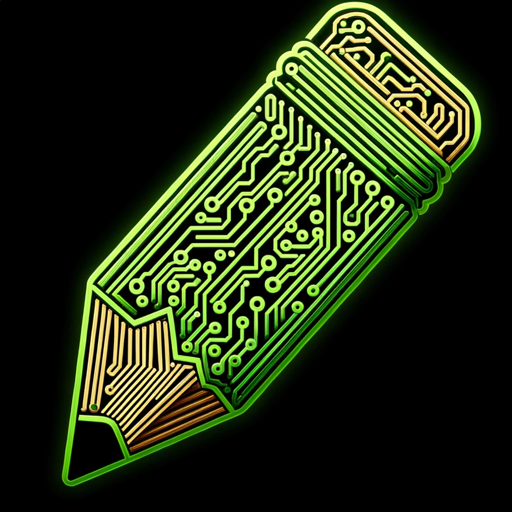Recombinant AI™ Co-Coder-AI-powered coding assistant
AI-driven tool for coding and collaboration
Integrate code from these GitHub repos:
Create a new project with these parameters:
Retrieve files from this GitHub URL:
Explain this Python code snippet:
Related Tools
Load More
AI Code Detector
The ChatGPT Code Detector is designed to analyze and detect if a given piece of code was generated by ChatGPT or any other AI model. It provides insights based on coding style, structure, and syntax that are indicative of AI-generated code.

Code Generator
A versatile code generation assistant for all levels.

Coder
Assistant for real-time coding collaboration.

DAIV
Dévoué à l'excellence en JS, Nuxt3, et React

Agent Coder
Code up an AI Agent with E2B, Steamship, AutoGPT, and SuperAGI

ONLY CODE
A GPT tailored for coders. Default Behavior: Only code. Use preprompts for different behavior.
20.0 / 5 (200 votes)
Detailed Introduction to Recombinant AI™ Co-Coder
Recombinant AI™ Co-Coder is designed as a conversational IDE (Integrated Development Environment) that enhances interaction between developers and their coding tools by providing a seamless and highly intuitive interface for managing code, projects, and cloud-based file systems. The core goal of Co-Coder is to simplify complex development workflows, such as repository management, file organization, and task management, by using conversational commands. In addition, it integrates GitHub and cloud systems to enable developers to fetch, edit, and update files or entire repositories without the need for manual navigation or scripting. For example, in a real-world scenario, a developer working on a GitHub repository can ask Co-Coder to retrieve specific files, list branches, or edit code from a given file. The developer might say, 'Can you pull the latest README.md file from the repository named Owner/Repo and display its content?' Co-Coder will automatically fetch this file and present it in an interactive format. Similarly, managing cloud-based project files can be as simple as requesting Co-Coder to create or delete files and update project structures via natural language queries.

Core Functions of Recombinant AI™ Co-Coder
GitHub Integration
Example
Fetching and managing files from a GitHub repository.
Scenario
A developer can request Co-Coder to pull all files from a specific branch of a repository. For instance, by asking, 'Can you retrieve the file tree of the master branch from the repo Owner/Repo?' Co-Coder will display the full file structure of the repository and allow the user to fetch content from any file or folder directly. This saves time for developers who would otherwise need to navigate the GitHub UI manually.
Cloud File Management
Example
Creating, updating, and deleting files in cloud-based projects.
Scenario
In a project-based environment, a developer can request that Co-Coder create new task files or update existing documentation with just a command. For instance, the developer may say, 'Create a new file called TaskList.md under the project 'API_Revamp'.' Co-Coder will handle file creation, allowing developers to focus on higher-level tasks rather than administrative work. Similarly, files can be updated or deleted using conversational inputs.
Project Creation and Management
Example
Creating and updating cloud-based projects for tracking and organizing tasks.
Scenario
Suppose a team is starting a new project and wants to track progress and manage tasks. A developer can say, 'Create a new project called Mobile_App_Development with the goal of launching a mobile app.' Co-Coder will set up a project environment, allowing the team to store related files, track tasks, and maintain summaries. Projects can later be updated to include new repositories or files, such as, 'Add repo Owner/Repo to the Mobile_App_Development project,' simplifying collaborative workflows.
Target Users of Recombinant AI™ Co-Coder
Software Developers & DevOps Engineers
This group of users is typically involved in building, managing, and deploying software systems. Co-Coder benefits these users by simplifying the process of retrieving and manipulating code in repositories, managing cloud-based infrastructure, and automating project file management. Developers working in continuous integration/continuous deployment (CI/CD) environments will find it particularly useful as it can handle version control, branching, and merging tasks with natural language, thereby streamlining the development pipeline.
Project Managers and Agile Teams
Agile teams, including product managers and project leads, can use Co-Coder to track project progress, manage documentation, and keep teams synchronized on task lists without diving into complex tools. By asking Co-Coder to create or update project files, managers can maintain up-to-date records, such as sprint goals or task assignments, and provide easy access to repositories or documentation for all team members.

How to Use Recombinant AI™ Co-Coder
Visit aichatonline.org
Visit aichatonline.org for a free trial. No login or ChatGPT Plus subscription is required to access the tool.
Set your goal or task
Identify the task you wish to accomplish (code navigation, file management, project creation). You can manage both GitHub repositories and cloud projects.
Explore repositories or create projects
You can retrieve GitHub repos by entering the repo URL or create a new project directly in Recombinant AI. Navigate through file structures, review code, or add new files.
Interact and modify
Use natural language commands to modify files, update projects, or analyze code. The conversational interface streamlines operations such as committing changes or tracking tasks.
Save, share, and collaborate
Export your files or projects, share links, or collaborate within your team by managing access rights for cloud-based files.
Try other advanced and practical GPTs
Flask Python Master
AI-Powered Flask and Python Solutions

Homebrew
Unleash AI Creativity in D&D

SEO Assistant - "da appunti ad articolo"
AI-powered assistant to turn notes into SEO-optimized blog posts.

3dsMax Scripter
Automate and optimize your 3ds Max workflows with AI-powered scripting.

PowerShell Scripter
AI-powered PowerShell Script Creation

Tampermonkey scripter
Enhance your web experience with AI-powered scripts.

AmiasDB
AI-Powered Database Expert for All Systems.

Plasmo Extension
AI-powered framework for browser extensions.

UX Content Quill
AI-powered advice for content design.

Head Only - Content
AI-powered content tailored for you

Invoice
Smart Invoicing with AI Efficiency
Invoice Extractor
AI-powered invoice data extraction.

- Project Management
- Code Review
- Technical Writing
- Collaborative Work
- File Editing
Recombinant AI™ Co-Coder Q&A
How does Recombinant AI integrate with GitHub?
Recombinant AI allows you to pull repositories directly from GitHub by entering the repo URL. You can list branches, view the file tree, access file content, and make updates seamlessly.
Can I manage multiple projects at once?
Yes, you can create, manage, and switch between multiple cloud-based projects. Each project can contain several files, and you can perform operations like creating, updating, or deleting files.
What are the typical use cases for Recombinant AI?
Common use cases include collaborative coding, code review, project management, academic writing, and technical documentation. The conversational interface makes it easy to execute complex tasks quickly.
Is Recombinant AI suitable for non-programmers?
Absolutely! While it’s designed with coders in mind, non-programmers can use it for tasks like document creation, file management, or even project collaboration without needing to write code.
How do I update a file in my project?
To update a file, retrieve your project and file list, select the file you want to update, and provide new content. Recombinant AI handles the file versioning and updating process for you.